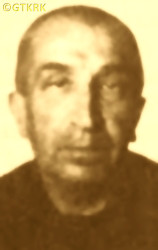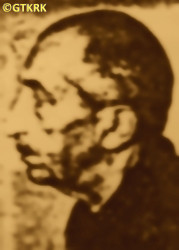Roman Catholic
St Sigismund parish
05-507 Słomczyn
85 Wiślana Str.
Konstancin deanery
Warsaw archdiocese, Poland
full list:
displayClick to display full list

searchClick to search full list by categories
wyświetlKliknij by wyświetlić pełną listę po polsku

szukajKliknij by przeszukać listę wg kategorii po polsku

Martyrology of the clergy — Poland
XX century (1914 – 1989)
personal data
surname
RUDENKO
forename(s)
Andronicus (pl. Andronik)
function
diocesan priest
creed
Latin (Roman Catholic) Church RCmore on
en.wikipedia.org
[access: 2014.09.21]
diocese / province
Lutsk‐Zhytomyr diocese (aeque principaliter)more on
www.catholic-hierarchy.org
[access: 2021.12.19]
honorary titles
Order of Saint Stanislav (Russian Empire) 3rd classmore on
Order of Saint Stanislav (Russian Empire) 3rd class
(c. 1916)
nationality
Russian
date and place
of death
08.05.1951

ITL SevVostLagGuLAG slave labour camp network
today: Vanino, Khabarovsk Krai, Russia
more on
en.wikipedia.org
[access: 2022.01.09]
details of death
During World War I officer of the Russian army (1915‐1918) — warrant officer, junior officer at an infantry battalion (from 1915); second lieutenant (from 30.11.1916); commander of the telephone unit (from 1916); Staff Captain (from 21.09.1917); demobilized (on 11.02.1918).
In 1917 convert to Catholicism from Orthodoxy — whole Orthodox parish n. Bila Tserkva converted with him.
Had the right to say Masses both in Latin and Eastern rites, granted by the Holy See.
Survived the genocidal hunger (Holodomor) in Ukraine, in particular in 1932/3.
Persecuted — Russian robbed him of his 3,000 volumes of books collected, among others.
Arrested by the Russians on 22.08.1935 in his Ivanopil parish.
On 13.12.1935, pursuant to Art. 54‐10‐1 of the Russian criminal code, sentenced (prob. in Vinnytsia) to 7 years of slave labour in Russian concentration camps.
Transported to ITL NorilLag concentration camp, but in 06.1936 managed to escape from the railway truck standing at Krasnoyarsk station.
Got back to Moscow.
There met — prob. in French embassy — with Moscow Apostolic Administrator, Bp Eugene Neveu who supported him with 225 rubbles.
Next 11 months spent in hiding in Romaniv town in Zhytomyr oblast.
Next attempted to reach Polish consulate in Kiev but was prob. regarded as an agent provocateur.
From Kiev moved to Berdychiv, and next to his former Ivanopil parish.
There hid at his parishioners (among others in Korchevka and Osyechna village where lived in a barn).
On 23.12.1937 returned to Kiev.
Finally arrested by the Russians on 11.12.1938 in Kiev.
There held in NKVD prison.
On 25.09.1939, pursuant to Art. 54‐10‐1, Art. 68a‐2 and Art. 78 of the Russian criminal code, sentenced by Russian district court in Kiev to 10 years slave labour in Russian concentration camps.
On 18.04.1940 transported to Vladivostok and then on 14.07.1940 to Magadan port in Magadan oblast on the Sea of Okhotsk, an entry point to the ITL SevVostLag–Kolyma Russian slave labour concentration camp system.
There slaved in a medical shop of local MagLag sub‐camp.
From 02.1945 — after finishing medical nursing courses — a slave qualified medical support.
On 11.01.1947 moved south to Primorsky Krai, to another part of ITL SevVostLag.
Held in a sub‐camp in Nakhodka on a little inlet of Nakhodka bay of Japan Sea (Bukhta Nakhodka), where slaved as medical support as well.
In 10.1950 held in a sub‐camp in Nakhodka on a little inlet of Nakhodka bay of Japan Sea (Bukhta Nakhodka).
On 02.09.1947 arrested in the camp and transferred to camp's inner prison back in Magadan.
On 15.09.1947 accused on „anti–Russian agitation and membership of illegal organisation”.
On 25.01.1948 medical commission established the he had a stroke and moved him to camp's hospital, where stayed till 07.07.1948.
On 04.11.1948, pursuant to Art. 58‐10‐2 of the Russian criminal code, sentenced to further 10 years of slave labour in Russian concentration camps.
On 06.10.1950 his health deteriorated further and was moved to camp's hospital in Vanino village on an inlet (Bukhta vanino) of Strait of Tartary in Khabarovsk Krai.
There perished.
cause of death
extermination
perpetrators
Russians
sites and events
ITL SevVostLagClick to display the description, ITL NorilLagClick to display the description, GulagClick to display the description
date and place
of birth
17.05.1894

Chernyshitoday: Kaniv hrom., Cherkasy rai., Cherkasy obl., Ukraine
more on
ru.wikipedia.org
[access: 2025.08.19]
alt. dates and places
of birth
Stavyshchetoday: Stavyshche hrom., Bila Tserkva rai., Kiev obl., Ukraine
more on
en.wikipedia.org
[access: 2021.09.17]
parents
RUDENKO Dmitry
🞲 ?, ? — 🕆 ?, ?

🞲 ?, ? — 🕆 ?, ?
presbyter (holy orders)
ordination
1920

positions held
1929 – 1935
administrator — Chudnivtoday: Chudniv hrom., Zhytomyr rai., Zhytomyr obl., Ukraine
more on
en.wikipedia.org
[access: 2021.09.17] ⋄ Exaltation of the Holy Cross RC parish ⋄ Liubartoday: Liubar hrom., Zhytomyr rai., Zhytomyr obl., Ukraine
more on
en.wikipedia.org
[access: 2021.09.17] RC deanery — also: minister of neighboring parishes, including Januszpol
1929 – c. 1935
priest — Yanushpoltoday: Ivanopil, Krasnopil hrom., Berdychiv rai., Zhytomyr obl., Ukraine
more on
en.wikipedia.org
[access: 2021.09.17] ⋄ RC church ⋄ Krasnopiltoday: Krasnopil hrom., Berdychiv rai., Zhytomyr obl., Ukraine
more on
uk.wikipedia.org
[access: 2022.08.05], Immaculate Heart of the Blessed Virgin Mary RC parish ⋄ Liubartoday: Liubar hrom., Zhytomyr rai., Zhytomyr obl., Ukraine
more on
en.wikipedia.org
[access: 2021.09.17] RC deanery
c. 1928 – 1929
vicar — Kievtoday: Kiev city rai., Kiev city obl., Ukraine
more on
en.wikipedia.org
[access: 2023.03.02] ⋄ St Alexander the Pope and Martyr RC parish ⋄ Kievtoday: Kiev city rai., Kiev city obl., Ukraine
more on
en.wikipedia.org
[access: 2023.03.02] RC deanery — ministering in Polish and Latin
c. 1920 – c. 1928
administrator — Vynarivkatoday: Stavyshche hrom., Bila Tserkva rai., Kiev obl., Ukraine
more on
uk.wikipedia.org
[access: 2021.09.17] ⋄ St John the Evangelist RC parish ⋄ Kievtoday: Kiev city rai., Kiev city obl., Ukraine
more on
en.wikipedia.org
[access: 2023.03.02] RC deanery
1919 – 1920
student — Kievtoday: Kiev city rai., Kiev city obl., Ukraine
more on
en.wikipedia.org
[access: 2023.03.02] ⋄ history of art, Historical–Philological Department, Kiev University
1918 – c. 1920
student — Kievtoday: Kiev city rai., Kiev city obl., Ukraine
more on
en.wikipedia.org
[access: 2023.03.02] ⋄ philosophy and theology, Theological Academy, Russian Orthodox Church
till 1915
student — Kievtoday: Kiev city rai., Kiev city obl., Ukraine
more on
en.wikipedia.org
[access: 2023.03.02] ⋄ military school
c. 1913
teacher — Stavyshchetoday: Stavyshche hrom., Bila Tserkva rai., Kiev obl., Ukraine
more on
en.wikipedia.org
[access: 2021.09.17] ⋄ elementary school
others related
in death
BAUŽYSClick to display biography Zeno, JACHNIEWICZClick to display biography Stanislav, SZCZEPANIUKClick to display biography Nicholas
sites and events
descriptions
ITL SevVostLag: Russian Rus. Исправи́тельно‐Трудово́й Ла́герь (Eng. Corrective Labor Camp) ITL Rus. Северо‐Восточный (Eng. North‐East) — concentration and slave forced labor camp (within the Gulag complex), known also as „Kolyma” — initially headquartered in Ust‐Srednekan, and then in Magadan on the Bay of Nagayev in the Magadan Oblast. Founded on 01.04.1932. Prisoners slaved at searching, developing, mining and exploiting deposits of gold, tin, tungsten, cobalt, molybdenum, radioactive raw materials and coal in dozens of mines in the region, building and operating mineral processing and enrichment plants, building access roads and railway lines, building and maintaining a number of hydroelectric power plants, power plants and combined heat and power plants, power lines, construction of river ports, airports, cities, repair and mechanical workshops, factories of construction and supporting materials (cement, glass, rubber, production of refractory materials, bricks, sulfuric acid, steel), in fishing and agriculture, etc. At its peak — till the death on 05.03.1953 of Russian socialist leader, Joseph Stalin — c. 200,000 prisoners were held there: e.g. 70,414 (01.01.1937); 90,741 (01.01.1938); 138,170 (01.01.1939); 190,309 (01.07.1940); 179,041 (01.01.1941); 166,445 (01.07.1941); 147,976 (01.01.1942); 99,843 (01.01.1943); 76,388 (01.01.1944); 87,335 (01.01.1945); 69,389 (01.01.1946); 79,613 (01.01.1947); 106,893 (01.01.1948); 108,685 (01.01.1949); 131,773 (01.01.1950); 157,001 (01.01.1951); 170,557 (01.01.1952). The prisoners were transported on ships to Magadan port on the Sea of Okhotsk, an entry point to the camp, prior to be sent to target sub‐camps. Up to 6 mln of the perished. Ceased to exist not earlier than 20.09.1949 and not later than 20.05.1952. (more on: old.memo.ruClick to attempt to display webpage
[access: 2024.04.08], www.gulagmuseum.orgClick to attempt to display webpage
[access: 2019.05.30])
ITL NorilLag: Russian Rus. Исправи́тельно‐Трудово́й Ла́герь (Eng. Corrective Labor Camp) ITL Rus. Норильский (Eng. Norylskiy) — concentration and slave forced labor camp (within the Gulag complex) — headquartered in Norilsk in Krasnoyarsk Krai, one of the most northern towns of the Earth. Founded on 25.06.1935. Prisoners slaved at the in the construction and operation of copper‐nickel plants, construction of mines and mining of platinum, nickel, cobalt, copper, coal, coke batteries, construction and operation of refineries, construction of the city of Norilsk, thermal power plants, waterworks, construction of river ports and shipyards, in geological exploration and research , construction of railway lines, in woodworking plants, mechanical and repair workshops, etc. At its peak — till the death on 05.03.1953 of Russian socialist leader, Joseph Stalin — c. 73,000 prisoners were held there: e.g. 47,732 (01.01.1948); 57,463 (01.01.1949); 58,651 (01.01.1950); 72,490 (01.01.1951); 68,849 (01.01.1952); 67,889 (01.01.1953); 36,734 (01.01.1954) — altogether up to 400,000, including 300,000 political. Ceased to exist on 22.08.1956. (more on: old.memo.ruClick to attempt to display webpage
[access: 2024.04.08])
Gulag: The acronym Gulag comes from the Rus. Главное управление исправительно‐трудовых лагерей и колоний (Eng. Main Board of Correctional Labor Camps). The network of Russian concentration camps for slave labor was formally established by the decision of the highest Russian authorities on 27.06.1929. Control was taken over by the OGPU, the predecessor of the genocidal NKVD (from 1934) and the MGB (from 1946). Individual gulags (camps) were often established in remote, sparsely populated areas, where industrial or transport facilities important for the Russian state were built. They were modeled on the first „great construction of communism”, the White Sea‐Baltic Canal (1931‐1932), and Naftali Frenkel, of Jewish origin, is considered the creator of the system of using forced slave labor within the Gulag. He went down in history as the author of the principle „We have to squeeze everything out of the prisoner in the first three months — then nothing is there for us”. He was to be the creator, according to Alexander Solzhenitsyn, of the so‐called „Boiler system”, i.e. the dependence of food rations on working out a certain percentage of the norm. The term ZEK — prisoner — i.e. Rus. заключенный‐каналоармец (Eng. canal soldier) — was coined in the ITL BelBaltLag managed by him, and was adopted to mean a prisoner in Russian slave labor camps. Up to 12 mln prisoners were held in Gulag camps at one time, i.e. c. 5% of Russia's population. In his book „The Gulag Archipelago”, Solzhenitsyn estimated that c. 60 mln people were killed in the Gulag until 1956. Formally dissolved on 20.01.1960. (more on: en.wikipedia.orgClick to attempt to display webpage
[access: 2024.04.08])
sources
personal:
christking.infoClick to attempt to display webpage
[access: 2018.09.02], krzysztofpozarski.files.wordpress.comClick to attempt to display webpage
[access: 2019.04.16], www.rsvetal.narod.ruClick to attempt to display webpage
[access: 2019.05.30]
bibliographical:
„Fate of the Catholic clergy in USSR 1917‐1939. Martyrology”, Roman Dzwonkowski, SAC, ed. Science Society KUL, 2003, Lublin
original images:
krzysztofpozarski.files.wordpress.comClick to attempt to display webpage
[access: 2019.04.16], ipn.gov.plClick to attempt to display webpage
[access: 2019.02.02]
LETTER to CUSTODIAN/ADMINISTRATOR
If you have an Email client on your communicator/computer — such as Mozilla Thunderbird, Windows Mail or Microsoft Outlook, described at WikipediaPatrz:
en.wikipedia.org, among others — try the link below, please:
LETTER to CUSTODIAN/ADMINISTRATORClick and try to call your own Email client
If however you do not run such a client or the above link is not active please send an email to the Custodian/Administrator using your account — in your customary email/correspondence engine — at the following address:

giving the following as the subject:
MARTYROLOGY: RUDENKO Andronicus
To return to the biography press below:
 Click to return to biography
Click to return to biography










